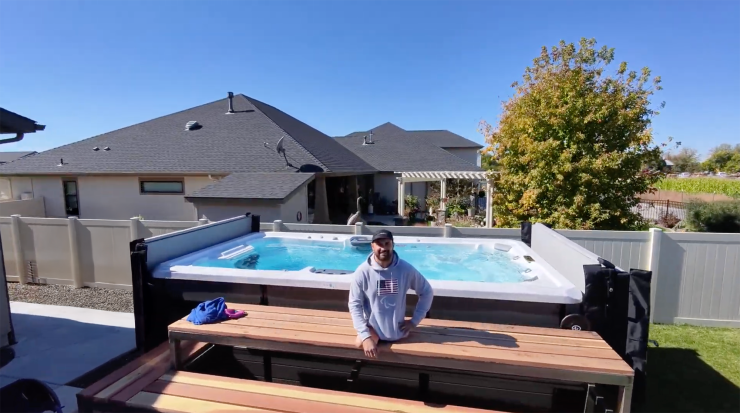Known for its sweeping landscapes, jagged peaks, and rose-colored rock, the Veneto Dolomites of northern Italy are not a place you’d expect to find Josh Sweeney.
Sweeney grew up in Phoenix, Arizona, surrounded by sand, sun, and heat. He joined the U.S. Marine Corps right out of high school, serving as a Scout Sniper in Afghanistan. That same sand and sun became the backdrop for the day that changed his life: an improvised explosive device left him a bilateral amputee at 22.
But what felt like an end became the start of something new: an opportunity to represent his country in a different way.
Sweeney expects to compete for the United States at the 2026 Paralympic Games in Nordic skiing. He’s also hopeful to join Team USA in Los Angeles in 2028, competing in paratriathlon.
To get there, though, takes training — and not just any kind.
From battlefield to the slopes
Sweeney wouldn’t have called himself an athlete growing up. He stayed active, playing ice hockey with friends and making occasional trips to the slopes in Flagstaff.
“I wouldn’t say I was athletic,” he says. “It was more for fun, for the camaraderie, and just to be part of something.”
After his injury in Afghanistan, sport took on a different meaning. What began as physical therapy soon became a way to rebuild his confidence and experience the camaraderie that he had in the Marines.
He found that opportunity through sled hockey. Within a few years, Sweeney was part of the U.S. sled hockey team at the 2014 Paralympic Games in Sochi, where he scored the game-winning goal that secured gold for Team USA.
“Sport was a huge part of my recovery — physically, emotionally, mentally, everything,” Sweeney says. “Being able to represent my country again after being injured was huge.
“To be able to contribute to my team in that way — that’s what I always wanted to do,” he says.
When his playing days on the ice ended, Sweeney looked for new challenges. He started cross-training, then competing in triathlons, and later discovered Nordic skiing and biathlon after moving to Idaho. The transition felt natural.
“The mechanics are so similar,” he explains. “In sled hockey you’re propelling yourself with both hands, and in skiing you’re doing the same with poles. It just clicked.”
Sweeney went on to compete in the 2022 Beijing Paralympic Games, finishing in the middle of the pack. It wasn’t the outcome he hoped for, but it reshaped his mindset. “Not everybody comes home with medals,” he says. “But I did my best and represented the country to the best of my abilities.”
Training for two Paralympic dreams
Balancing training for both winter and summer Paralympic sports is no small task. Nordic skiing demands endurance and upper-body power. Triathlon requires efficiency and speed across three disciplines — swimming, hand cycling, and racing in a wheelchair.
“There’s really no off time,” Sweeney says. “As soon as ski season ends, I’m in triathlon mode. Then, as soon as triathlon is done, I’m back to skiing. Swimming is the one thing I can do year-round that helps with both.”
The water has long been a place where Sweeney feels strong. He swam as a kid, and that confidence carried through his time in the Marines. After his injury, he rediscovered his love for the water. It was a place where he just felt good, moving freely and without limitation.
“I love swimming because it allows me to move in almost a weightless area,” he says. “I’m not feeling the pull of gravity, and I’m not sitting in my chair. I don’t need adaptive equipment. I can just put on a swimsuit and go.”
Finding freedom in the water
When Sweeney began training for paratriathlon, he quickly learned that access to a pool could be as challenging as the workouts themselves. Public lanes were often crowded or closed, and scheduling conflicts disrupted his training rhythm.
“I’d show up to a pool and sometimes couldn’t even get in,” he says. “I was already swimming three times a week, but I needed more. I needed time in the water if I wanted to be faster.”
Open-water practice, too, came with unique challenges. Without legs to act as a rudder, Sweeney found himself drifting off course in lakes or rivers.
“Staying straight in open water is tough,” he explains. “I just needed a way to train that would help me keep my form and build speed.”
In his search for a more sustainable option, Sweeney began to explore the benefits of a swim spa.
A swim spa built for performance
Sweeney was drawn to the H2X Challenger 15D — a swim spa made by Master Spas, which is headquartered in Indiana. Designed for fitness, recreation, and recovery, the Challenger swim spa creates a smooth, powerful current of water without air injection, providing the feel of open-water swimming.
“I love that it doesn’t have air in the jets,” he says. “I wanted it to feel like a real open-water swim, like when I’m out at the lake. The Challenger 15D gives me that.”
Having the swim spa at his home in Idaho means Sweeney can train whenever his schedule allows, year-round. He can now swim four to five times a week, mixing endurance sessions with easy recovery swims after long workouts or lifting sessions.
“It’s been huge for my training,” he says. “I can jump in and get a 30-minute swim done without worrying about lane space or traffic. It’s saving me time, but it’s also helping me mentally. I can focus on what I need to do, take care of my body, and still be present with my family.”
It’s more than just a training tool, though. Sweeney’s two young children often join him in the water.
“The kids love swimming against the current and letting it carry them back down,” he says with a laugh. “We can play, splash around, and still be home in time for bedtime.”
Building toward what’s next
As Sweeney prepares for his next two Paralympic Games, the Challenger 15D has become part of his daily rhythm. It helps him train smarter, recover faster, and stay consistent with his swimming routine.
“This partnership with Master Spas gives me confidence,” he says. “It’s giving me the tools I need to be successful — not just in competition, but in life.”


